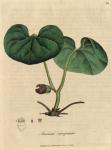086. Asarum europaeum. Common asarabacca.

 Synonyma. Asarum. Pharm. Lond. & Edinb. Bauh. Pin. p. 197. Gerard. Emac. p. 836. J. Bauh. Hist. vol. iii. p. 548. Ray Hist. p. 207. Synop. p. 158.
Synonyma. Asarum. Pharm. Lond. & Edinb. Bauh. Pin. p. 197. Gerard. Emac. p. 836. J. Bauh. Hist. vol. iii. p. 548. Ray Hist. p. 207. Synop. p. 158.
Asarum vulgare. Park. Theat. p. 266.
Asarum foliis reniformibus subhirsutis. Hal. Stirp. Helv. n. 1547.
Asarum Europaeum. Withering. Bot. Arrang. p. 488. Flor. Dan. 633.
Class Dodecandria. Ord. Monogynia. Lin. Gen. Plant. 589.
Ess. Gen. Ch. Cal. 3-f. 4-fidus, germini insidens. Cor. o Caps. coriacea, coronata.
Spec. Char. A. foliis reniformibus obtusis binis.
The root is perennial, strong, divided and fibrous: it has no stalk, so that the leaves rise immediately from the root; they grow in pairs, are kidney-shaped, large, of a deep shining green colour, and stand upon long footstalks: the flowers are large, bell-shaped, of a dirty purple colour, and placed singly upon short peduncles at the base of the footstalks: the calyx supplies the place of a corolla, and is large, bell-shaped, divided at the mouth into three or four pointed segments, which are of a brownish purple colour, but towards the base it is greenish: the filaments are twelve, about half the length of the calyx, and furnished with oblong antherae, which are attached to the sides of the filaments: from the germen arises a simple style, crowned with a stigma, divided into six radiated reflected parts: the capsule is of a leathery texture, and divided into six cells, which contain several small oblong seeds. It is a native of England, [It is extremely scarce. Ray observes it is found in some woods in Lancashire. l. c.] and flowers in May.
It appears from Pliny, [His. Nat. L. xii. c. 13. et L. xxi. cap. 6. Asaron, ab α priv. (greek), quoniam in coronis non addatur.] that by the Ancients the name of this plant was frequently confounded with that of nardus and baccharis; and the English name Asarabacca has been derived from the words asarum and baccharis: it is evident however that the plants, now known by these names, differ very considerably both in their appearance and effects.
"The leaves and roots of Asarum have a moderately strong and not very unpleasant smell, somewhat resembling that of valerian or nard, [Nardus Celttca L.] and a nauseous bitterish acrid taste:" [Lewis M. M. p. 122.] they seem to agree also in their medicinal effects, both proving strongly emetic and cathartic: the root has been observed to excite vomiting so constantly, that it is proposed by Linnaeus as a substitute for ipecacuanha; [Am. Acad. T. 7. p. 307. where it is also observed, that when exhibited in a state of very fine powder, it uniformly acts as an emetic, but when coarsely powdered it always passes the stomach and becomes cathartic.] and Dr. Cullen says, "the root dried only so much as to be powdered proves, in a moderate dose, a gentle emetic. It will commonly answer in doses of a scruple, sometimes in a less quantity," "and as we judge may be suited to many of the purposes of the ipecacuanha." [Mat. Med. vol. ii. p. 473.] In small doses it is said to promote perspiration, urine, and the uterine flux. ["Diureticum & emmenagogum insigne: unde Meretriculae plus satis frequentant decoctum ejus, cum sentiunt se gravidas. Quo tenuius est tritum eo magis urinas movere, minus autem alvum ducere, creditur." Ray Hist. p. 208.] Spirituous tinctures and watery infusions of the plant possess both its emetic and cathartic virtues, but it is said that by coction in water the emetic power is first destroyed, and afterwards the purgative. [Raii l. c.] At present Asarum is seldom given internally, as the evacuations expected from its use may be procured with more certainty and safety [Ante aliquot annos civis hujus loci, vir quadratus, difficulter mobilis, sumit, suasu aniculae, pulverem asari foliorum & radicis ad integrum cochlear. Inde vero hypercatharsin patiebatur lethalem," &c. Wedelius Amoenit. M. M. p. 240. & De Med.fac.] by various other medicines, that it is now chiefly employed as an errhine or sternutatory, and is found to be the most useful and convenient in the Mat. Med. For this purpose the leaves, as being less acrid than the roots, are preferred by the College, and in moderate doses, not exceeding a few grains, snuffed up the nose several successive evenings, produce a pretty large watery discharge, which sometimes continues for several days together, by which headach, toothach, opthalmia, and some paralytic and soporific complaints, have been effectually relieved. It is the basis of the pulv. sternutatorius, or pulvis asari compositus.

